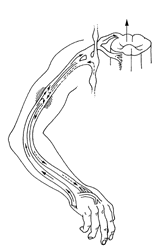|
Reflex Sympathetic Dystrophy
What is it?
Reflex sympathetic dystrophy, also known as RSD, is a condition of burning
pain, stiffness, swelling, and discoloration of the hand. RSD includes other
medical diagnoses like casualgia, Sudeck’s atrophy, and shoulder-hand syndrome.
RSD occurs from a disturbance in the sympathetic (unconscious) nervous system
that controls the blood flow and sweat glands in the hand and arm. When the
nervous system becomes overactive, burning pain is felt and swelling and warmth
are left in the affected arm. If not treated, RSD can cause stiffness and loss
of use of the affected part of the arm.
What causes it?
In some cases, the cause of RSD is unknown. Often an injury can cause RSD,
or the symptoms may appear after a surgery. Other causes include pressure on
a nerve, infection, cancer, neck disorders, stroke, or heart attack. These conditions
can cause pain, which sets off the sympathetic reflex causing RSD symptoms.
Nerve injuries may change the way the nerve impulses are sent, causing a “short
circuit” (Figure 1).
Signs and symptoms
The pain associated with relex sympathetic dystrophy is often described as
burning in nature. Swelling can cause painful joints and stiffness. RSD has
three stages:
- Acute: may last up to three months. During
this stage the symptoms include pain and swelling, increased warmth in the
affected part/limb, and excessive sweating. There may be faster-than-normal
nail and hair growth and joint pain during movement of the affected area (Figure
2).
- Dystrophic: can last three to 12 months.
Swelling is more constant, skin wrinkles disappear, skin temperature becomes
cooler, and fingernails become brittle. The pain is more widespread, stiffness
increases, and the affected area becomes sensitive to touch.
- Atrophic: occurs from one year on. The skin
of the affected area is now pale, dry, tightly stretched, and shiny. The area
is stiff, pain may decrease, and there is less hope of getting motion back.
Diagnosis
The diagnosis usually is made when at least three of the following symptoms
are present: pain and tenderness, signs of changed blood flow (either increased
or decreased), swelling with joint stiffness, or skin changes.
Treatment
Early diagnosis and treatment are important. Three forms of treatment may be
combined: medication, physical therapy, and surgery. Medication taken by mouth
can help decrease the symptoms. To reduce symptoms and provide long term relief,
local anesthetics may be injected into a nerve bundle at the base of the neck
(stellate ganglion block). In some cases, a tourniquet is applied to the arm
and medication can be injected into a vein along with an anesthetic. Your hand
surgeon may recommend therapy by a hand, occupational or physical therapist,
or physician. Therapy is important to regain function and reduce discomfort
caused by RSD. Successful treatment depends upon the patient’s full and active
effort in therapy. Occasionally surgery is performed in the later stages, but
the results can be disappointing. Your physician can advise you on the best
treatment for your situation.

Figure 1
On the right, the swollen, painful hand of early RSD with reddened joints.

Figure 2
This diagram shows how a nerve injury may cause a “short circuit” in the nervous
system resulting in sympathetic overactivity in the hand with burning pain,
swelling, and increased sweating.
Copyright © American Society for Surgery of the Hand.
All content copied with permission from ASSH (www.assh.org). |
| |
| Common Hand Problems and Diseases |
|
|
|